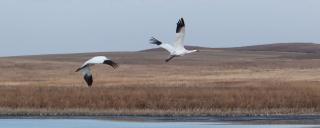

Whooping Crane
| Scientific Name | Grus americana |
|---|---|
| General Description | L 52”, WS 87”, 15 lb. All white except for black wing tips and a red crown. Long black legs set it apart from white pelicans which are sometimes confused for whoopers. |
| Status | Migrates through North Dakota in April to mid-May and September to early November. |
| Abundance | Rare. |
| Primary Habitat | Palustrine wetlands and cropland ponds. |
| Federal Status | Migratory Bird. |
| Reason for Designation | Listed as threatened in 1967 and endangered in 1970. Whooping Cranes formerly nested in North Dakota, but no nests have been recorded for more than 100 years. North Dakota provides important stopover habitat as the few birds left in the wild migrate through during both spring and fall. Listed as High Concern by Waterbird Conservation for the Americas. |
Locations and Conditions of Key Habitat
Preferred Habitat
During migration, use primarily wetlands and cropland ponds for roosting, feeding, or both. Seasonal, temporary and semipermanent wetlands are the most commonly used. Large, shallow wetlands are used for roosting and smaller wetlands for foraging. Feed mostly on frogs, fish, plant tubers, insects, crayfish, and waste grains during migration.
Key Areas and Conditions for Whooping Crane in North Dakota
A complete listing of named rivers, lakes, and reservoirs where Whooping Cranes have been sighted is in Austin and Richert, 2001. However, key stopover sites may be located anywhere throughout the migration corridor. HAPET has produced spatial models to depict areas important to Whooping Cranes.
Problems Which May Affect this Species
Habitat
Conversion of prairie breeding habitat for agriculture during settlement times, along with unregulated shooting in the late 19th and early 20th century resulted in the survival of only one relic breeding population in the Woods Buffalo National Park in Canada. Wetlands used as stopover habitat by Whooping Cranes remain at risk of destruction.
Other Natural or Manmade Factors
Delayed sexual maturity, small clutch size, and low recruitment rate has precluded a rapid recovery. Whooping Cranes may be easily disturbed, particularly on the breeding grounds. The wintering population along the Gulf Coast in Texas is at risk from contaminant spills, although the probability of a spill is low. Several accidental shootings have occurred in the last few years. Power line collisions are the most common cause of Whooping Crane mortalities in the last 50 years. Collisions with wind turbines is of increasing concern. Loss of genetic diversity. Intensifying oil and gas development in North Dakota overlaps with the migratory corridor of Whooping Cranes and there is increasing risk of oilfield contamination of stopover habitat.
Research and Survey Efforts
Current Research or Surveys
- Since 1975, the public has been asked to provide sightings of Whooping Cranes in North Dakota and in other states.
- Beginning in 2008, the Whooping Crane Tracking Partnership marked wild Whooping Cranes with GPS technology to better understand the migration pathways and wintering ecology of the Aransas-Wood Buffalo Whooping Cranes.
Previous Research or Surveys
- In 2001, a comprehensive review of migration site data was conducted. This includes information for North Dakota.
- Numerous published reports and gray literature.
Additional Research or Surveys Needed
Nothing at this time specific to North Dakota.
Population and Trend Estimates
- Continental Population Estimate: 419 (300 wild, 119 captive)
- Whooping Crane Recovery Plan Goal: for downlisting, the Aransas-Wood Buffalo population must be selfsustaining and remain above 1,000 individuals and 250 reproductive pairs.
Management Recommendations
- Continue to implement the recovery plan.
- Safeguard Whooping Cranes as they migrate through North Dakota, i.e. minimize human disturbance.
- Utility development should follow the guidance of “Reducing Avian Collisions with Power Lines” including marking power lines and creating an Avian Protection Plan.
- Wind industry companies should collaborate with the American Wind and Wildlife Institute for responsible wind development.
Monitoring Plans
Continue to report Whooping Crane sightings in the spring and fall in North Dakota to appropriate key contacts. The Aransas National Wildlife Refuge conducts an annual Whooping Crane census on the wintering grounds in Texas. The Central Flyway Technical Committees work with the U.S. Fish and Wildlife Service to update and develop survey protocol.
2005-2015 Progress
The Whooping Crane is a migrant in North Dakota and therefore remains a Level III Species of Conservation Priority.

Note: A listing of works consulted when compiling the information on this page may be found in the 2015 State Wildlife Action Plan.
